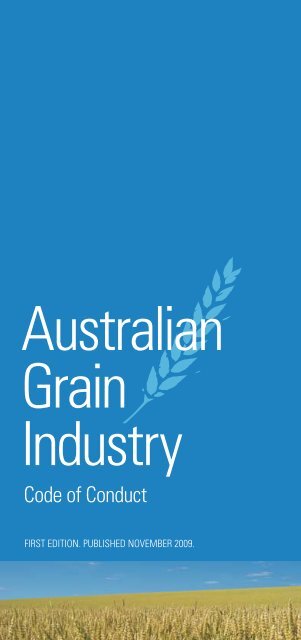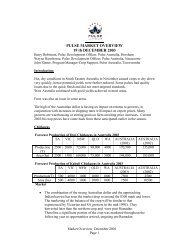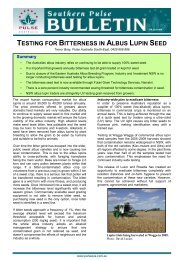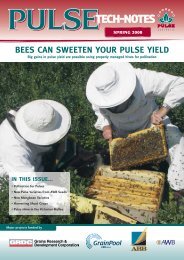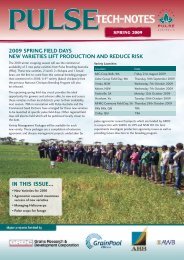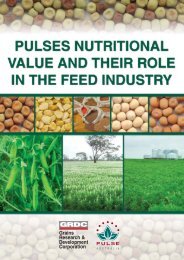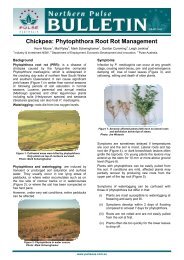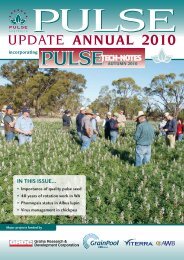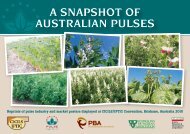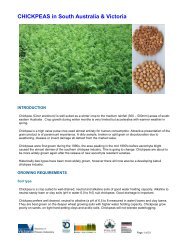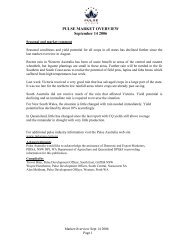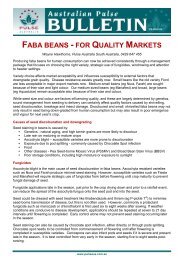Australian Grain Industry Code of Practice - Pulse Australia
Australian Grain Industry Code of Practice - Pulse Australia
Australian Grain Industry Code of Practice - Pulse Australia
You also want an ePaper? Increase the reach of your titles
YUMPU automatically turns print PDFs into web optimized ePapers that Google loves.
<strong><strong>Australia</strong>n</strong><br />
<strong>Grain</strong><br />
<strong>Industry</strong><br />
<strong>Code</strong> <strong>of</strong> Conduct<br />
First edition. Published November 2009.<br />
<strong><strong>Australia</strong>n</strong> <strong>Grain</strong> <strong>Industry</strong> <strong>Code</strong> <strong>of</strong> Conduct 1
Contents<br />
2<br />
<strong><strong>Australia</strong>n</strong> <strong>Grain</strong> <strong>Industry</strong> <strong>Code</strong> <strong>of</strong> Conduct
Contents<br />
<strong>Industry</strong> Endorsement ............................................................ 05<br />
Part One — Preliminary ........................................................ 07<br />
1.1 About the <strong>Code</strong>..................................................................... 07<br />
1.2 Objectives ............................................................................ 08<br />
1.3 The <strong><strong>Australia</strong>n</strong> grain industry supply chain<br />
and marketing relationships ............................................... 09<br />
Part Two — <strong>Code</strong> Requirements ......................................... 11<br />
2.1 Product Integrity/Standards................................................. 11<br />
2.2 Trade Rules........................................................................... 16<br />
2.3 <strong>Grain</strong> Contracts..................................................................... 17<br />
2.4 Pricing................................................................................... 21<br />
2.5 Training and Pr<strong>of</strong>essional Development.............................. 23<br />
Part Three — Dispute Resolution........................................ 25<br />
3.1 Dispute Resolution............................................................... 25<br />
Part Four — Administration.................................................. 28<br />
4.1 Application <strong>of</strong> the <strong>Code</strong>........................................................ 28<br />
4.2 <strong>Code</strong> Administration............................................................. 28<br />
Part Five — <strong>Industry</strong> Arrangements.................................... 31<br />
5.1 <strong>Grain</strong> Trade <strong>Australia</strong> (GTA).................................................. 31<br />
5.2 Other <strong>Industry</strong> <strong>Code</strong>s............................................................ 33<br />
Appendices.............................................................................. 36<br />
Appendix 1: <strong><strong>Australia</strong>n</strong> <strong>Industry</strong> <strong>Practice</strong>s<br />
and Regulation – Chemical Residues ........................................ 36<br />
Appendix 2: Publications and Courses....................................... 39<br />
Appendix 3: Contract Checklist.................................................. 40<br />
Glossary <strong>of</strong> Terms.................................................................... 41<br />
<strong><strong>Australia</strong>n</strong> <strong>Grain</strong> <strong>Industry</strong> <strong>Code</strong> <strong>of</strong> Conduct 3
<strong>Industry</strong> Endorsement<br />
4<br />
<strong><strong>Australia</strong>n</strong> <strong>Grain</strong> <strong>Industry</strong> <strong>Code</strong> <strong>of</strong> Conduct
<strong>Industry</strong> Endorsement<br />
The development <strong>of</strong> the <strong><strong>Australia</strong>n</strong> <strong>Grain</strong> <strong>Industry</strong> <strong>Code</strong> <strong>of</strong> Conduct<br />
has been facilitated by <strong>Grain</strong> Trade <strong>Australia</strong> on behalf <strong>of</strong> the<br />
industry and with the financial support <strong>of</strong> the <strong><strong>Australia</strong>n</strong> Government<br />
Department <strong>of</strong> Agriculture, Fisheries and Forestry as part <strong>of</strong> the<br />
wheat marketing transitional funding assistance measures for the<br />
new wheat export marketing arrangements that commenced on<br />
1 July 2008. The <strong>Code</strong> is endorsed by a range <strong>of</strong> industry<br />
organisations.<br />
The <strong><strong>Australia</strong>n</strong> <strong>Grain</strong> <strong>Industry</strong> <strong>Code</strong> <strong>of</strong> Conduct is intended to<br />
cover all industry participants in the <strong><strong>Australia</strong>n</strong> grain industry.<br />
The <strong>Code</strong> is a voluntary code and does not imply any contractual<br />
obligations. The <strong>Code</strong> has been designed to promote best practices<br />
and continually enhance behaviour <strong>of</strong> industry participants.<br />
To further the interests <strong>of</strong> the industry as a whole, a list <strong>of</strong><br />
organisations and businesses who endorse the <strong>Code</strong> and<br />
commit to promoting the <strong>Code</strong> to their members is published<br />
on the <strong>Grain</strong> Trade <strong>Australia</strong> website www.graintrade.org.au<br />
<strong>Industry</strong> participants who abide by the <strong><strong>Australia</strong>n</strong> <strong>Grain</strong> <strong>Industry</strong><br />
<strong>Code</strong> <strong>of</strong> Conduct will:<br />
comply with laws and regulations relating to the merchandising,<br />
inspection, grading, weighing, storing and handling <strong>of</strong> grain and<br />
other commodities<br />
maintain and promote the highest ethical standards and<br />
procedures in the transaction <strong>of</strong> business<br />
act fairly and honestly with the public and employees<br />
consider the best interests <strong>of</strong> the <strong><strong>Australia</strong>n</strong> grain, and broader<br />
rural, industry and the public in their activities<br />
work towards improving the standards <strong>of</strong> practice and service<br />
in the <strong><strong>Australia</strong>n</strong> grain industry<br />
<strong><strong>Australia</strong>n</strong> <strong>Grain</strong> <strong>Industry</strong> <strong>Code</strong> <strong>of</strong> Conduct 5
Part One<br />
6<br />
<strong><strong>Australia</strong>n</strong> <strong>Grain</strong> <strong>Industry</strong> <strong>Code</strong> <strong>of</strong> Conduct
Part One — Preliminary<br />
1.1 About the <strong>Code</strong><br />
The <strong><strong>Australia</strong>n</strong> <strong>Grain</strong> <strong>Industry</strong> <strong>Code</strong> (the <strong>Code</strong>) has been designed<br />
to help set benchmarks and continually improve behaviour and<br />
practices in the <strong><strong>Australia</strong>n</strong> grain industry.<br />
The <strong>Code</strong> sets out principles and standards <strong>of</strong> behaviour that<br />
underpin and promote best practice in the industry.<br />
Although the <strong>Code</strong> primarily addresses the transactions and<br />
processes relating to the buying and selling <strong>of</strong> grain, it also seeks<br />
to actively encourage fair and transparent practices across the grain<br />
supply chain.<br />
The <strong>Code</strong> encourages industry participants to support an efficient<br />
and competitive grain industry. The <strong>Code</strong> encompasses trade in<br />
grain by parties within the grain supply chain – from growers to end<br />
users and/or export in bulk vessels or in containers, but not including<br />
consumers.<br />
The <strong>Code</strong> also incorporates a fair and equitable dispute resolution<br />
procedure.<br />
Nature <strong>of</strong> the <strong>Code</strong><br />
The aim <strong>of</strong> the <strong>Code</strong> is to improve the transparency and clarity <strong>of</strong><br />
transactions relating to the buying and selling <strong>of</strong> grain.<br />
The <strong>Code</strong> is intended to guide the conduct <strong>of</strong> industry participants,<br />
but does not constitute a contract between them. The <strong>Code</strong> aims to<br />
promote behaviour that is based on all parties undertaking to operate<br />
in a fair and transparent manner in all commercial relationships<br />
relating to the sale or purchase <strong>of</strong> grain between supply chain<br />
participants.<br />
The <strong><strong>Australia</strong>n</strong> <strong>Grain</strong> <strong>Industry</strong> <strong>Code</strong> <strong>of</strong> Conduct is a voluntary code.<br />
The provisions <strong>of</strong> the <strong>Code</strong> are subject to all applicable<br />
Commonwealth, State and Territory legislation and all rights<br />
and obligations arising under common law.<br />
Scope<br />
The <strong>Code</strong> covers the grain industry supply chain and the commercial<br />
relationships between suppliers and purchasers <strong>of</strong> grain at different<br />
stages <strong>of</strong> production or distribution in the grain industry supply chain<br />
– from farm gate to the <strong><strong>Australia</strong>n</strong> end user and/or grain export in<br />
bulk vessels or in containers, but not including consumers.<br />
<strong><strong>Australia</strong>n</strong> <strong>Grain</strong> <strong>Industry</strong> <strong>Code</strong> <strong>of</strong> Conduct 7
The <strong>Code</strong> applies to all grain commodities at any point in the supply<br />
chain and to all forms <strong>of</strong> packaging i.e. bulk, containers, bags, etc.<br />
The <strong>Code</strong> should, however, assist in providing confidence for buyers<br />
<strong>of</strong> <strong><strong>Australia</strong>n</strong> grain, whether in <strong>Australia</strong> or in overseas markets.<br />
It will assist in giving buyers confidence that there is uniform<br />
treatment <strong>of</strong> product by parties in the supply chain.<br />
The <strong>Code</strong> is intended to promote fair behaviour by all those involved<br />
in producing, handling, transporting, marketing and buying grain.<br />
The <strong>Code</strong> specifically covers relationships with regard to the buying<br />
and selling <strong>of</strong> grain. In the future, the <strong>Code</strong> could be extended to<br />
cover relationships within the handling, storage and transport areas.<br />
The grain industry has a number <strong>of</strong> other codes <strong>of</strong> practices, quality<br />
assurance systems (ISO, HACCP, etc) and accreditation schemes that<br />
cover activities in the industry such as product integrity, storage and<br />
handling, transport, seed production and sale, processing and food<br />
safety. These codes are described in Part 5.<br />
The <strong>Code</strong> was developed to improve the confidence <strong>of</strong> sellers<br />
and buyers, transparency across the supply chain and behaviour<br />
<strong>of</strong> participants in the supply chain. The <strong>Code</strong> should benefit the<br />
grain industry by:<br />
Improving business practices and information flows<br />
Providing greater transparency to all parties in the supply chain<br />
Improving stakeholder and customer confidence in the industry<br />
The signatories to the <strong>Code</strong> will actively promote the adoption <strong>of</strong><br />
the <strong>Code</strong> by their members.<br />
1.2 Objectives<br />
The objectives <strong>of</strong> the <strong><strong>Australia</strong>n</strong> <strong>Grain</strong> <strong>Industry</strong> <strong>Code</strong> <strong>of</strong> Conduct<br />
are to:<br />
promote fair and equitable trading practices amongst industry<br />
participants<br />
encourage fair play and open communication between industry<br />
participants<br />
promote best practice in the industry by seeking a commitment<br />
to comply with the spirit and intent <strong>of</strong> all laws, regulations and<br />
codes that have an impact on the industry<br />
provide a timely and cost effective dispute resolution mechanism<br />
for industry participants in the event <strong>of</strong> a dispute<br />
encourage pr<strong>of</strong>essional development and industry training<br />
8<br />
<strong><strong>Australia</strong>n</strong> <strong>Grain</strong> <strong>Industry</strong> <strong>Code</strong> <strong>of</strong> Conduct
1.3 The <strong><strong>Australia</strong>n</strong> grain industry supply<br />
chain and marketing relationships<br />
The <strong><strong>Australia</strong>n</strong> grain industry comprises a range <strong>of</strong> participants<br />
from technology researchers, plant breeding and seed companies<br />
which develop and produce varieties required by growers, to<br />
growers who grow and manage the crops and a range <strong>of</strong> logistic and<br />
marketing organisations involved in ensuring the harvested<br />
crop reaches the end customer.<br />
The supply chain stretches from farm through country receival sites<br />
to domestic end users and/or export marketers and international end<br />
users. Other participants in the chain include storage, grain trading<br />
and merchandising, container packing and grain brokers. At each link<br />
<strong>of</strong> the supply chain there are sellers and buyers whose interaction<br />
creates the markets and associated activities.<br />
Growers can choose to market their grain via a range <strong>of</strong> options.<br />
This initial parcel <strong>of</strong> grain may be bought and sold a number <strong>of</strong> times<br />
as it moves through the supply chain to its ultimate destination and<br />
use. As grain moves through the supply chain it is aggregated into<br />
larger parcels, is transported to differing locations, is blended and<br />
conditioned into more uniform and suitable quality, and is stored<br />
until required by the market.<br />
Country Receival/<br />
Container packing<br />
Export<br />
(bulk, containers)<br />
Farm<br />
Accumulators,<br />
Traders,Marketers,<br />
Brokers, etc<br />
Domestic end users<br />
(Milling, Stockfeed<br />
manufacture, Oilseed<br />
processing, Malting)<br />
<strong>Code</strong> covers sales/purchases between these points and any interim transactions.<br />
<strong>Grain</strong> may change hands multiple times between these points<br />
<strong><strong>Australia</strong>n</strong> <strong>Grain</strong> <strong>Industry</strong> <strong>Code</strong> <strong>of</strong> Conduct 9
Part Two<br />
10<br />
<strong><strong>Australia</strong>n</strong> <strong>Grain</strong> <strong>Industry</strong> <strong>Code</strong> <strong>of</strong> Conduct
Part Two —<br />
<strong>Code</strong> Requirements<br />
2.1 Product Integrity/Standards<br />
Background<br />
The <strong>Code</strong> seeks to build buyer confidence through:<br />
providing evidence <strong>of</strong> compliance with regulatory<br />
and market requirements in relation to chemicals, labelling<br />
and processing<br />
the supply chain maintaining product quality and integrity and<br />
providing traceability<br />
providing accurate descriptions <strong>of</strong> products (truth in labelling)<br />
across the supply chain<br />
Product Standards<br />
Trade in the <strong><strong>Australia</strong>n</strong> grain industry is based on a set <strong>of</strong> grain<br />
standards and contracts that enable buyers to have clarity and<br />
confidence in the products they purchase; and growers to have clarity<br />
around the requirements and pricing <strong>of</strong> the product they supply.<br />
<strong>Grain</strong> standards in <strong>Australia</strong> are published by GTA (Refer to Part<br />
5). GTA develops and distributes standards for wheat and coarse<br />
grains. The <strong><strong>Australia</strong>n</strong> Oilseeds Federation is responsible for the<br />
development <strong>of</strong> standards for oilseeds, <strong>Pulse</strong> <strong>Australia</strong> develops<br />
standards for pulses and the Queensland Agricultural Merchants<br />
develop standards for birdseed. The GTA Standards Committee scope<br />
and process is outlined in Part 5 and these <strong>Grain</strong> Standards are<br />
available from www.graintrade.org.au<br />
The GTA <strong>Grain</strong> Standards are underpinned by industry classification<br />
and accreditation systems such as for barley (Barley <strong>Australia</strong>) and<br />
wheat (Wheat Classification Council).<br />
For each new variety <strong>of</strong> malting barley bred in <strong>Australia</strong>, there<br />
is a rigorous series <strong>of</strong> evaluations and hurdles the variety must<br />
pass in order to gain accreditation as a recognised malting barley<br />
variety. After new barley varieties have been routinely screened for<br />
agronomic and processing performance by the breeding institutions<br />
they are subjected to further micro and commercial scale testing<br />
for suitability to brewing. The final accreditation section <strong>of</strong> the<br />
evaluation process takes place over two seasons to ensure a broad<br />
examination <strong>of</strong> the variety. Full accreditation is achieved after<br />
the second season’s evaluation results have been examined and<br />
approved by the <strong><strong>Australia</strong>n</strong> barley industry’s technical evaluation<br />
<strong><strong>Australia</strong>n</strong> <strong>Grain</strong> <strong>Industry</strong> <strong>Code</strong> <strong>of</strong> Conduct 11
panel – The Malting and Brewing <strong>Industry</strong> Barley Technical<br />
Committee (MBIBTC).<br />
With the changes in wheat marketing arrangements in <strong>Australia</strong>,<br />
GRDC has established a two tiered system for wheat classification<br />
– the Wheat Classification Council (WCC) to establish grades and<br />
grade requirements and the Variety Classification Panel (VCP) to<br />
grade varieties.<br />
Wheat varietal classification is the categorisation <strong>of</strong> wheat<br />
varieties into grades based on processing and end product quality.<br />
Wheat varietal classification together with wheat grain standards<br />
aims to deliver grain <strong>of</strong> consistent physical quality, processing<br />
performance and end-product quality to customers and end-users<br />
in a differentiated form (grades) allowing exporters (or traders) to<br />
optimise value capture from markets for the benefit <strong>of</strong> industry.<br />
The two key functions required for wheat varietal classification are:<br />
i. establishing the grades i.e. determining the specific make up <strong>of</strong><br />
grades required by end-users and the formulation <strong>of</strong> criteria by<br />
which a variety would be considered to be eligible for a given<br />
grade. These criteria must, and should, evolve in response to<br />
changing market signals (a function <strong>of</strong> the Wheat Classification<br />
Council); and<br />
ii. grading <strong>of</strong> varieties i.e. the technical and objective process for<br />
assessing a variety or proposed variety against a given grade<br />
criteria (a function <strong>of</strong> the Varietal Classification Panel).<br />
In addition to grain quality, there are a number <strong>of</strong> other industry<br />
codes <strong>of</strong> practices that seek to protect product quality and integrity.<br />
These are listed in Part 5.<br />
Chemical residues and product safety<br />
The <strong><strong>Australia</strong>n</strong> grain industry has a range <strong>of</strong> quality assurance and<br />
industry protocols that, combined with a world recognised regulatory<br />
system, underpin buyer confidence in the safety and compliance <strong>of</strong><br />
<strong><strong>Australia</strong>n</strong> grain with market requirements.<br />
This combination <strong>of</strong> industry quality assurance systems and<br />
<strong><strong>Australia</strong>n</strong> Government legislation provide a whole-<strong>of</strong>-chain<br />
approach to food safety, residue management and the provision<br />
<strong>of</strong> grain according to customer requirements. This approach has<br />
proved effective in establishing <strong>Australia</strong> as a creditable producer<br />
and supplier <strong>of</strong> grain commodities. All practices are based on sound<br />
science and are consistent with international policy and standards<br />
for ensuring safe and suitable food.<br />
12<br />
<strong><strong>Australia</strong>n</strong> <strong>Grain</strong> <strong>Industry</strong> <strong>Code</strong> <strong>of</strong> Conduct
The key elements <strong>of</strong> this system are (refer to Appendix 1 for<br />
further details):<br />
Chemical Registration – Chemicals are registered for both<br />
pre-harvest and post-harvest use on grain. In <strong>Australia</strong> there<br />
are two Government bodies responsible for registration <strong>of</strong><br />
chemicals and for determining maximum residue limits <strong>of</strong><br />
chemicals. <strong><strong>Australia</strong>n</strong> MRLs are generally either the same as,<br />
or more stringent than, those prescribed by the international<br />
<strong>Code</strong>x Alimentarius Commission.<br />
<strong>Australia</strong> is a full signatory to the World Health Organisation’s<br />
<strong>Code</strong>x Alimentarius Commission recommendations with<br />
respect to pre and post harvest grain protectant chemicals.<br />
The <strong><strong>Australia</strong>n</strong> recommendations on the registration and use <strong>of</strong><br />
chemicals, which reflect these <strong>Code</strong>x Standards, are binding in<br />
all <strong><strong>Australia</strong>n</strong> States. To access the <strong><strong>Australia</strong>n</strong> MRL database<br />
go to: www.apvma.gov.au/residues/mrl.shtml and the Food<br />
Standards <strong>Australia</strong> New Zealand (FSANZ) website address is:<br />
www.foodstandards.gov.au<br />
Chemical Usage and Monitoring – The <strong><strong>Australia</strong>n</strong> National<br />
Residue Survey (NRS) gathers information on chemical<br />
residues and environmental contaminants in the products <strong>of</strong><br />
participating industries, such as crops, meat and grain. The<br />
NRS results show <strong><strong>Australia</strong>n</strong> grain is <strong>of</strong> a high quality with<br />
respect to residues and contaminants. Information about the<br />
NRS is located: www.daff.gov.au/nrs<br />
Export <strong>Grain</strong> Regulations – The <strong><strong>Australia</strong>n</strong> Government<br />
Department <strong>of</strong> Agriculture, Fisheries and Forestry (DAFF)<br />
controls exports under the Export Control Act 1982. The<br />
<strong><strong>Australia</strong>n</strong> Quarantine and Inspection Service (AQIS) is part <strong>of</strong><br />
DAFF and is responsible for this task.<br />
AQIS interfaces with the grain industry through the AQIS<br />
<strong>Grain</strong>s <strong>Industry</strong> Consultative Committee (AGICC). AGICC is the<br />
principal advisory forum for AQIS to consult with the grain and<br />
related industries on export certification, export market access,<br />
quarantine and other relevant issues. Accordingly, the AQIS<br />
<strong>Grain</strong> and Plant Products Export Program only introduces major<br />
policy or operational changes after AGICC has been consulted.<br />
<strong>Industry</strong> quality systems – Across the <strong><strong>Australia</strong>n</strong> grain supply<br />
chain from on-farm production to export in bulk vessels or<br />
containers, there are a range <strong>of</strong> systems and controls in<br />
place in order for all exports to meet the importing country<br />
quarantine regulations, quality requirements, chemical residue<br />
limits and other standards as necessary. <strong>Industry</strong> developed<br />
quality control checks are carried out from the time grain is<br />
<strong><strong>Australia</strong>n</strong> <strong>Grain</strong> <strong>Industry</strong> <strong>Code</strong> <strong>of</strong> Conduct 13
eceived into storage up to the time it is placed on a shipping<br />
belt for loading onto a vessel for export, into a container<br />
for export, or it is delivered to a domestic end-user. Quality<br />
checks are carried out during storage to confirm the integrity <strong>of</strong><br />
segregations and to ensure there is no deterioration <strong>of</strong> quality<br />
as a result <strong>of</strong> insect infestation, unsound storage practices, or<br />
admixture between grain types or grades.<br />
Declarations<br />
Commodity vendor declaration forms are routinely used in the<br />
grain supply chain on receipt <strong>of</strong> grain from a grower or during<br />
the transfer <strong>of</strong> ownership within the trade. These commodity<br />
vendor declaration forms can include details such as chemical<br />
residue status, variety and quality status <strong>of</strong> the grain. More<br />
recently, declarations have also encompassed a declaration<br />
on GM status <strong>of</strong> grain. This information is used by the buyer or<br />
handler <strong>of</strong> the grain to verify the grain meets regulations and/or<br />
market requirements.<br />
There are various formats <strong>of</strong> these commodity vendor declaration<br />
forms used in the industry, depending on the company receiving<br />
the grain.<br />
Variety declarations are also important for commercial reasons.<br />
This is increasingly the case as the application <strong>of</strong> End Point<br />
Royalties (EPR) become more widespread. The industry is seeking<br />
to establish a National EPR Framework and members <strong>of</strong> the<br />
breeding community have developed a standardised agreement<br />
to licence new varieties to growers. The intent <strong>of</strong> a standardised<br />
agreement is to avoid confusion and reduce the number <strong>of</strong><br />
different contracts currently being used to licence proprietary<br />
varieties to growers. Breeding organisations and commercial<br />
partners are encouraged to utilise these standard agreements.<br />
The <strong>Industry</strong> Standard PBR Licence Agreement and list <strong>of</strong> the<br />
varieties to which Plant Breeder Rights/End Point Royalties apply<br />
are available at www.grdc.com.au<br />
14<br />
<strong><strong>Australia</strong>n</strong> <strong>Grain</strong> <strong>Industry</strong> <strong>Code</strong> <strong>of</strong> Conduct
<strong>Code</strong> requirements – chemicals<br />
i. Growers and other suppliers will maintain written records<br />
that demonstrate compliance with regard to use <strong>of</strong> chemicals<br />
with legislation and market requirements and, where required,<br />
make these available to buyers.<br />
<strong>Code</strong> requirements – truth in labelling<br />
i. Buyers will communicate relevant grain standards and<br />
specifications to their suppliers in clear, meaningful and<br />
accurate terms.<br />
ii. Where grain is rejected, buyers will provide the reason or reasons<br />
to their supplier. Such reasons shall be based on the relevant<br />
grain standards and specifications or other objective criteria and<br />
be consistent with the terms and conditions <strong>of</strong> the contract and<br />
GTA Trade Rule requirements as applicable.<br />
iii. Parties will undertake to correctly represent the product as per<br />
the grain standards, and where the product is sold outside <strong>of</strong><br />
the industry standards, it will not be represented as being <strong>of</strong><br />
equivalent to a defined industry standard.<br />
iv. Buyers will make their suppliers aware <strong>of</strong> the relevant grain<br />
standards and specifications prior to the supplier entering into<br />
a contract. Where grain standards vary from the GTA <strong>Grain</strong><br />
Standards or other applicable standards, buyers will make<br />
their suppliers aware <strong>of</strong> these variations.<br />
<strong>Code</strong> requirements – variety identity and traceability<br />
i. Growers will declare varieties as required by buyers and, where<br />
appropriate, make efforts to keep these separate to the best <strong>of</strong><br />
their ability. Separation may be required for end point royalties,<br />
market benefit or process e.g. GM.<br />
ii. All industry participants will provide traceability <strong>of</strong> product<br />
through the supply chain where this is required by the market and<br />
specifically in relation to chemical residues and product safety.<br />
<strong>Code</strong> requirements – end point royalties<br />
i. Breeding companies and their commercial partners will promote<br />
and utilise the standard industry agreement or a document that is,<br />
at least, equivalent.<br />
ii. All parties will make efforts to ensure EPRs are correctly declared<br />
and records maintained as per the EPR contract. Growers<br />
recognise they have an obligation to ensure EPRs are or have<br />
been paid (either directly or by the marketer).<br />
iii. Companies supplying EPR agreements to growers should use<br />
standard terms and conditions, or where these differ, ensure<br />
growers are aware <strong>of</strong>, and understand, these.<br />
<strong><strong>Australia</strong>n</strong> <strong>Grain</strong> <strong>Industry</strong> <strong>Code</strong> <strong>of</strong> Conduct 15
2.2 Trade Rules<br />
Background<br />
Contractual relationships between parties in the grain industry are<br />
bound by provisions <strong>of</strong> contract law, government legislation, industry<br />
rules such as the GTA Trade Rules or the specific provisions <strong>of</strong> the<br />
terms and conditions <strong>of</strong> the specific contract<br />
The GTA Trade Rules govern the rules and guidelines that underpin<br />
the majority <strong>of</strong> transactional relationships in the industry. All parties<br />
involved in buying and selling grain should be familiar with the<br />
GTA Trade Rules and ensure they understand the terminology <strong>of</strong><br />
the industry.<br />
The <strong>Code</strong> aims to improve transparency and remove the opportunity<br />
for ambiguity or misunderstanding by parties to a transaction by<br />
developing and using common definitions across the industry.<br />
The GTA Trade Rules assist to harmonise the various contracts and<br />
trade rules in operation within the <strong><strong>Australia</strong>n</strong> market. GTA Trade<br />
Rules underpin the GTA Contracts and are the basis <strong>of</strong> trade for other<br />
specialty grain contracts. The Trade Rules reflect trade practices and<br />
facilitate trade between buyers and sellers in the grain industry.<br />
The GTA Commerce Committee formulates and recommends GTA<br />
Trade Rule changes. The operations and guidelines for the Commerce<br />
Committee are outlined in Part 5.<br />
The GTA Trade Rules govern disputes connected with grain<br />
trade based on GTA contracts and form the basis <strong>of</strong> arbitration<br />
unless otherwise and specifically agreed at the time <strong>of</strong> trade or<br />
a subsequent time.<br />
The GTA Trade Rules cover:<br />
Terms <strong>of</strong> trade – what should be specified e.g. date <strong>of</strong> contract,<br />
kind and quality grade <strong>of</strong> commodity, type <strong>of</strong> quality inspection,<br />
quantity, type <strong>of</strong> weights, packaging, price, price basing point,<br />
transportation, delivery/shipment period, applicable trade rules,<br />
levies and statutory charges, payment terms, other terms and<br />
conditions<br />
Confirmation <strong>of</strong> trade – contract confirmed in writing by close<br />
<strong>of</strong> business the day following the date <strong>of</strong> trade<br />
Alteration <strong>of</strong> contract – mutual agreement and confirmed<br />
in writing<br />
Brokerage – definition, powers and payment<br />
Time – delivery or shipment periods, timeliness <strong>of</strong> notices<br />
Quantity – definition, tolerances, weights<br />
16<br />
<strong><strong>Australia</strong>n</strong> <strong>Grain</strong> <strong>Industry</strong> <strong>Code</strong> <strong>of</strong> Conduct
Quality – grades<br />
Chemical and pesticide residues – commodity complies with all<br />
State and Federal laws and requirements relating to chemical and<br />
pesticide residues and specified government designated maximum<br />
residue levels<br />
Certificates<br />
Unpriced contracts – cash price made up <strong>of</strong> futures, basis and<br />
foreign exchange<br />
Delivery and settlement – defined, instructions<br />
Rejection/default<br />
Payment<br />
Notices<br />
Force Majeure<br />
Disputes – parties who have entered into terms <strong>of</strong> trade subject to<br />
GTA rules are entitled to refer disputes arising out <strong>of</strong> such contract<br />
to GTA<br />
The GTA Trade Rules are available from www.graintrade.org.au<br />
<strong>Code</strong> requirements<br />
i. All parties involved in buying and selling grain will conduct<br />
trading activities in accordance with the GTA Trade Rules, or<br />
practices equivalent to or exceeding the GTA Trade Rules, and<br />
all parties should have a full appreciation <strong>of</strong> the GTA Trade Rules.<br />
ii. Buyers should, when using industry terminology, use this in line<br />
with the intent <strong>of</strong> the definition. Buyers should, where required,<br />
explain terminology so that sellers understand their obligations.<br />
2.3 <strong>Grain</strong> Contracts<br />
Background<br />
<strong>Grain</strong> is traded under contracts which may be created either verbally<br />
or in writing or using a combination <strong>of</strong> verbal and writing. Once<br />
reached, these contracts are legally binding on both parties. Contract<br />
confirmation is issued confirming the agreement.<br />
The majority <strong>of</strong> grain in <strong>Australia</strong> is traded on GTA contracts.<br />
This <strong>Code</strong> aims to promote contract negotiations being conducted<br />
in a fair and transparent way and that buyers provide to growers/<br />
sellers, when requested, full disclosure <strong>of</strong> the terms and conditions<br />
relating to a contract, including fees and charges.<br />
<strong><strong>Australia</strong>n</strong> <strong>Grain</strong> <strong>Industry</strong> <strong>Code</strong> <strong>of</strong> Conduct 17
The elements which should be clear and recorded by the contracting<br />
parties include:<br />
Price<br />
Price basis<br />
Delivery date or period<br />
Grade/standard<br />
Tonnage and tolerances<br />
Fees and/or charges applicable<br />
Payment terms<br />
Default procedures<br />
Dispute resolution<br />
Contracts are open to negotiation and a buyer or seller has the<br />
right to negotiate on any points <strong>of</strong> the contract.<br />
GTA has developed the following contracts for use within the<br />
<strong><strong>Australia</strong>n</strong> grain trade. These contracts reference their own<br />
Terms and Conditions and the GTA Trade & Dispute Resolution<br />
Rules. Parties who use the contracts as published agree to the<br />
Terms & Conditions and the GTA Trade & Dispute Resolution Rules<br />
as published.<br />
The GTA contract is a standard industry contract available for use<br />
by the industry. Growers and sellers should note that some industry<br />
participants have their own contracts, which may mirror many <strong>of</strong> the<br />
GTA contract features, but may also contain variations.<br />
GTA Contracts include:<br />
Contract No. 1 for <strong>Grain</strong> and Oilseeds in Bulk FOB Terms<br />
This contract is used by grain traders who aggregate tonnage<br />
for sale to an organisation who has arranged export sales and<br />
accordingly is responsible for shipping arrangements. Title to the<br />
grain transfers to the buyer when the grain passes the ships rail.<br />
Contract No. 2 for <strong>Grain</strong> and Oilseeds in Bulk Delivered Price<br />
Basing Point or Port Terms (Basis Track)<br />
This contract is used by the post farm gate trade to aggregate<br />
substantial tonnages for domestic end user requirements or export<br />
shipments. This contract is not designed to be used by grain growers.<br />
Contract No. 3 for <strong>Grain</strong> and Oilseeds<br />
This contract is designed for trade between grain growers and<br />
merchants. It needs to be noted that many merchants/traders<br />
have their own grower contract which may or may not contain<br />
the same terms and conditions as the GTA contract.<br />
18<br />
<strong><strong>Australia</strong>n</strong> <strong>Grain</strong> <strong>Industry</strong> <strong>Code</strong> <strong>of</strong> Conduct
Contract No. 4 for <strong>Grain</strong>/Oilseeds/Birdseeds and <strong>Pulse</strong>s in<br />
containers Delivered Container Terminal (DCT)<br />
This contract is used by grain sellers who pack and then<br />
deliver containerised grain for domestic or international<br />
shipping. Title in the grain transfers upon receipt <strong>of</strong> the<br />
packed container in the container terminal yard.<br />
Storage & Handling Agreement<br />
This agreement can be used by grain growers who are<br />
warehousing grain and the warehouse does not have an<br />
agreement. This agreement has clauses dealing with grain<br />
title and insolvency <strong>of</strong> the relevant warehouse.<br />
Bulk Freight Contract<br />
Designed to enforce contractual obligations on both the<br />
consignee and consignor in relation to the bulk movement<br />
<strong>of</strong> grain particularly by road transport. This contract should<br />
be utilised in conjunction with the <strong>Code</strong> <strong>of</strong> <strong>Practice</strong> developed<br />
by GTA in conjunction with the Livestock and Bulk Carriers<br />
Association.<br />
Buyers may <strong>of</strong>fer a range <strong>of</strong> grain contracts that may incorporate a<br />
range <strong>of</strong> features that increase the complexity <strong>of</strong> the contract and<br />
may or may not reference the use <strong>of</strong> derivative products or underlying<br />
futures markets or may be deemed a Financial Product as defined by<br />
the Financial Services Reform Act.<br />
Contracts that may fall under this category include (but are not<br />
limited to) commodity futures contracts, basis contracts, hedge to<br />
arrive contracts, futures first contracts, futures look-a-like contracts<br />
such as: swaps; bought and sold options on physical or futures<br />
markets; contracts dealing with foreign exchange; and contracts<br />
connected to a managed investment scheme.<br />
<strong>Industry</strong> participants considering utilising any <strong>of</strong> these types<br />
<strong>of</strong> contracts should ensure that they understand the nature <strong>of</strong><br />
the contract, its pricing characteristics, the risks in relation to<br />
the contract and under what circumstances and through what<br />
mechanism the original terms <strong>of</strong> the contract can be altered.<br />
Growers should clearly understand at the time <strong>of</strong> contracting<br />
what the implications are in the event <strong>of</strong> production difficulties<br />
and the inability to fulfil contract obligations due to reduced or<br />
failed production.<br />
GTA has produced a plain English guide – A Guide to Taking Out<br />
Contracts to Supply <strong>Grain</strong> – which can be downloaded from the GTA<br />
website. This Guide covers the major issues that growers need to be<br />
aware <strong>of</strong> when contracting grain. This is not a substitute to reading<br />
and understanding the terms and conditions <strong>of</strong> the contract.<br />
<strong><strong>Australia</strong>n</strong> <strong>Grain</strong> <strong>Industry</strong> <strong>Code</strong> <strong>of</strong> Conduct 19
<strong>Code</strong> requirements<br />
i. <strong>Grain</strong> contracts will clearly define payment and other contract<br />
terms. Where terms and conditions are outside the industry<br />
standard as defined in the GTA Trade Rules, buyers should make<br />
their supplier aware <strong>of</strong> these terms.<br />
ii. Buyers will make efforts to ensure that if terms and conditions<br />
are amended, this change is clearly identified and brought to the<br />
attention <strong>of</strong> their seller. Growers should be aware <strong>of</strong> the contract<br />
which they are negotiating with regard to: whether it is a GTA<br />
Contract or a company contract; and be aware if it is the latter that<br />
the contract may vary from the standard GTA Contract. Parties should<br />
note: any amendments apply to the base contract being negotiated<br />
which may not necessarily be equivalent to the GTA Contract.<br />
iii. Buyers will record in the contract confirmation, whether<br />
conducted verbally by telephone or by written facsimile, wire,<br />
email or mail, the following information:<br />
Date <strong>of</strong> contract<br />
Kind and quality grade <strong>of</strong> commodity<br />
Type <strong>of</strong> quality inspection<br />
Quantity<br />
Type <strong>of</strong> weights<br />
Packaging<br />
Price<br />
Price basing point<br />
Transportation specification<br />
Delivery or shipment period<br />
Applicable trade rules<br />
Levies and statutory charges<br />
iv. Growers will advise the buyer <strong>of</strong> any registered crop liens.<br />
v. Buyers will make efforts to ensure there is transparency <strong>of</strong> the<br />
their seller’s obligations and rights under the contract they are<br />
entering into. Various publications and courses are available to<br />
assist parties in understanding contracts. These are detailed in<br />
Appendix 2.<br />
vi. Buyers and sellers will make efforts to ensure all verbal contract<br />
discussions are closed with a clear summary <strong>of</strong> the agreement<br />
and the terms. After a contract has been confirmed, this should<br />
be followed by a written confirmation as per the GTA Trade<br />
Rules. The Contract Checklist (refer Appendix 3) can be used by<br />
sellers to ensure all elements <strong>of</strong> the contract are clear and by<br />
buyers to ensure clarity by both parties <strong>of</strong> the contract agreed to.<br />
20<br />
<strong><strong>Australia</strong>n</strong> <strong>Grain</strong> <strong>Industry</strong> <strong>Code</strong> <strong>of</strong> Conduct
vii. Suppliers and buyers will negotiate the terms and conditions<br />
<strong>of</strong> their contracts (including terms <strong>of</strong> payment) in clear, concise,<br />
meaningful and accurate terms.<br />
viii. Where variations to the contract (GTA or other contract) are<br />
agreed, these will be confirmed between the parties in a clear<br />
and transparent manner. Amendments to a contract should be in<br />
writing and should be separate to the standard contract. Growers<br />
should be aware <strong>of</strong> the contract which they are negotiating with<br />
regard to: whether it is a GTA contract or a company contract;<br />
and be aware if it is the latter that the contract may vary from<br />
the standard GTA Contract.<br />
ix. Buyers should reference the GTA Dispute Resolution Service<br />
in all contracts in order to resolve disputes in a timely and cost<br />
effective manner.<br />
2.4 Pricing<br />
Background<br />
The <strong>Code</strong> aims to improve transparency and to encourage clear<br />
disclosure with regard to prices including the basis <strong>of</strong> pricing, what is<br />
included, what is excluded and what charges apply.<br />
The <strong>Code</strong> applies to cash prices and Pools.<br />
<strong>Grain</strong> Pools<br />
Pools involve: the acquisition by a Pool manager <strong>of</strong> grain primarily from<br />
grain producers as well as other grain market participants; the sale <strong>of</strong><br />
that grain over time and; after making adjustments and deductions in<br />
relation to individual deliveries (e.g. quality adjustments, logistics cost<br />
deductions, management fee deductions), the distribution <strong>of</strong> the net<br />
average Pool return to all participants in the Pool.<br />
At the time a party delivers to a Pool, title in the grain is transferred to<br />
the Pool operator. Title must change to allow the Pool manager to have<br />
clear title enabling sales to be made prior to the closure <strong>of</strong> the Pool.<br />
Pool managers will announce and regularly update an estimated<br />
Pool return. As a general principle, estimated returns will reflect<br />
a reasonable expectation <strong>of</strong> what could be expected to be paid.<br />
These estimates will be subject to change throughout the life <strong>of</strong> a<br />
Pool. There is no guarantee that this figure will be achieved, as it is an<br />
estimate based on available information and assumptions relevant<br />
at that time. The final Pool return will depend on multiple factors,<br />
in particular, the management <strong>of</strong> the marketing program by the Pool<br />
operator and market movements over the life <strong>of</strong> the Pool.<br />
<strong><strong>Australia</strong>n</strong> <strong>Grain</strong> <strong>Industry</strong> <strong>Code</strong> <strong>of</strong> Conduct 21
<strong>Code</strong> requirements<br />
i.<br />
ii.<br />
Buyers and other industry participants will implement the<br />
following protocols:<br />
publish all fees and charges associated with any products<br />
or services in a transparent and clear manner. This will<br />
be achieved by buyers posting all fees and charges on<br />
their respective web sites and/or making such information<br />
freely available upon application<br />
quote all prices before allowing for statutory and<br />
industry levies<br />
deduct statutory and industry levies, as required by law<br />
and remit same to the relevant agency<br />
post all prices exclusive <strong>of</strong> GST<br />
<strong>Industry</strong> participants who <strong>of</strong>fer grain Pools will implement the<br />
following protocols:<br />
Pool estimates (expressed on either a Free on Board (FOB)<br />
or Estimated Silo Return (ESR) basis) will be posted net <strong>of</strong><br />
management and administration fees<br />
Advance Pool silo based estimates (ESR) will be posted net<br />
<strong>of</strong> estimated finance and compulsory underwriting costs<br />
Loan payment Pool silo based estimates with fixed draw<br />
down schedules will be posted net <strong>of</strong> estimated finance<br />
and compulsory underwriting costs<br />
Regularly update changes to estimated returns by posting<br />
updates at regular intervals (usually at least monthly) on<br />
their web site<br />
Have in place the necessary skills, payment systems, risk<br />
systems/procedures and resources you could reasonably<br />
expect to be in place to manage the Pools that they <strong>of</strong>fer<br />
and regularly review these to evaluate the currency <strong>of</strong><br />
their application<br />
22<br />
<strong><strong>Australia</strong>n</strong> <strong>Grain</strong> <strong>Industry</strong> <strong>Code</strong> <strong>of</strong> Conduct
2.5 Training and Pr<strong>of</strong>essional Development<br />
The <strong>Code</strong> encourages pr<strong>of</strong>essional development though the continual<br />
development <strong>of</strong> training to maintain high pr<strong>of</strong>essional standards.<br />
<strong>Industry</strong> participants should train staff (and authorised<br />
representatives and/or registered <strong>of</strong>ficers) so they can competently<br />
and efficiently discharge their functions and provide the services<br />
they are authorised to provide and have an adequate knowledge <strong>of</strong><br />
the provisions <strong>of</strong> this <strong>Code</strong>.<br />
GTA conducts a comprehensive pr<strong>of</strong>essional development program<br />
across <strong>Australia</strong>. Each year GTA trains in excess <strong>of</strong> 300 grain industry<br />
personnel. Workshops are conducted in each State on a range <strong>of</strong><br />
topics including contract terms & conditions, trade rules, <strong><strong>Australia</strong>n</strong><br />
Financial Services Licence, commodity pricing, arbitration and<br />
grain accounting.<br />
GTA <strong>of</strong>fers the Pr<strong>of</strong>essional Certificate in <strong>Grain</strong> Marketing which<br />
can be combined with further modules leading to the Pr<strong>of</strong>essional<br />
Diploma in Commodity Trading Management. The Pr<strong>of</strong>essional<br />
Certificate in <strong>Grain</strong> Marketing course includes modules on:<br />
GTA Trade Rules, Contracts & Dispute Resolution<br />
<strong>Grain</strong> Commodity Marketing & Trading<br />
<strong>Grain</strong> Standards<br />
NACMA WA, Curtin University and Department <strong>of</strong> Primary<br />
<strong>Industry</strong> WA developed the Understanding <strong>Grain</strong> Markets course<br />
that has been an outstanding success in WA. GTA will conduct the<br />
Understanding <strong>Grain</strong> Markets course in all States except Western<br />
<strong>Australia</strong> from 2009.<br />
In addition, modules are being developed for <strong>Grain</strong> Accounting<br />
and Arbitration.<br />
<strong><strong>Australia</strong>n</strong> <strong>Grain</strong> <strong>Industry</strong> <strong>Code</strong> <strong>of</strong> Conduct 23
Part Three<br />
24<br />
<strong><strong>Australia</strong>n</strong> <strong>Grain</strong> <strong>Industry</strong> <strong>Code</strong> <strong>of</strong> Conduct
Part Three —<br />
Dispute Resolution<br />
3.1 Dispute Resolution<br />
The <strong>Code</strong> supports the GTA Dispute Resolution Service which is a<br />
comprehensive, timely and cost effective dispute resolution process<br />
developed for the grain industry.<br />
All GTA arbitrations are subject to the Commercial Arbitration<br />
Act 1984 (NSW). This Act should be read in conjunction with the<br />
applicable GTA Dispute Resolution and Trade Rules in order to<br />
understand how the arbitration will be conducted and the rules<br />
that govern it. If one <strong>of</strong> the parties to an arbitration is foreign, the<br />
International Arbitration Act will also apply.<br />
The GTA Dispute Resolution Service:<br />
considers all vertical supply disputes arising between industry<br />
participants<br />
gives all industry participants an opportunity to resolve disputes<br />
under industry procedures<br />
considers all disputes fairly and impartially<br />
does not jeopardise the underlying commercial relationship<br />
respects the confidentiality <strong>of</strong> applicants and respondents<br />
encourages an equitable and timely resolution <strong>of</strong> disputes<br />
Dispute Resolution Service<br />
Over 95% <strong>of</strong> all grain contracts written in <strong>Australia</strong> rely on the GTA<br />
Trade Rules and/or GTA <strong>Grain</strong> Standards. GTA Contracts and Trade<br />
Rules contain agreements to refer disputes to the GTA Dispute<br />
Resolution Service. Parties to contracts incorporating the GTA Trade<br />
Rules are obliged to refer any dispute to GTA for settlement under<br />
the GTA Dispute Resolution Service.<br />
GTA administers disputes referred for determination under the<br />
GTA Dispute Resolution Rules and provides administrative support<br />
to arbitrations. GTA conducts an arbitration service for contract<br />
disputation. The three methods to resolve a dispute are:<br />
Expert Determination: both parties supply their version <strong>of</strong> events<br />
leading to the dispute to an expert endorsed by both parties.<br />
The expert considers the evidence and submits a non binding<br />
opinion on the relative merits <strong>of</strong> both submissions and makes<br />
a determination<br />
<strong><strong>Australia</strong>n</strong> <strong>Grain</strong> <strong>Industry</strong> <strong>Code</strong> <strong>of</strong> Conduct 25
Fast Track Arbitration: designed for a rapid determination <strong>of</strong> a<br />
dispute and works best where there is goodwill from both parties<br />
to reach a fair and equitable conclusion<br />
Full Arbitration<br />
The Service is open to all participants <strong>of</strong> the grain trade, not only<br />
GTA members.<br />
GTA Contracts and Trade Rules are backed by the <strong><strong>Australia</strong>n</strong> legal<br />
framework. GTA Trade Rules and Contracts have been challenged at<br />
the following jurisdictions – Small Claims Tribunals; County Court<br />
and the State Supreme Courts. In all cases the various jurisdictions<br />
upheld the GTA Awards handed down as part <strong>of</strong> the GTA Dispute<br />
Resolution Service or ordered the parties to refer their dispute to<br />
GTA for arbitration.<br />
GTA arbitrations are subject to the provisions <strong>of</strong> the GTA Dispute<br />
Resolution Rules and the Commercial Arbitration Acts in all states<br />
<strong>of</strong> <strong>Australia</strong> and can be appealed at court. Arbitration awards are<br />
no less enforceable than judgements <strong>of</strong> the courts.<br />
The dispute resolution process and procedures are outlined in the<br />
documents: GTA Arbitration Guidelines, GTA Dispute Resolution<br />
Rules and Request an Arbitration with GTA. These publications<br />
are available from the GTA website www.graintrade.org.au<br />
26<br />
<strong><strong>Australia</strong>n</strong> <strong>Grain</strong> <strong>Industry</strong> <strong>Code</strong> <strong>of</strong> Conduct
Part Four<br />
<strong><strong>Australia</strong>n</strong> <strong>Grain</strong> <strong>Industry</strong> <strong>Code</strong> <strong>of</strong> Conduct 27
Part Four —<br />
<strong>Code</strong> Administration<br />
The <strong><strong>Australia</strong>n</strong> <strong>Grain</strong> <strong>Industry</strong> <strong>Code</strong> <strong>of</strong> Conduct will be maintained<br />
and administered by <strong>Grain</strong> Trade <strong>Australia</strong>. GTA is the appropriate<br />
custodian <strong>of</strong> the <strong>Code</strong> as it is the body responsible for the<br />
development and distribution <strong>of</strong> the commercial resources<br />
for the <strong><strong>Australia</strong>n</strong> grain industry.<br />
4.1 Application <strong>of</strong> the <strong>Code</strong><br />
The <strong><strong>Australia</strong>n</strong> <strong>Grain</strong> <strong>Industry</strong> <strong>Code</strong> <strong>of</strong> Conduct is endorsed by key<br />
industry groups which are committed to promoting adherence to the<br />
<strong>Code</strong> by their members.<br />
The <strong>Code</strong> is intended to set a benchmark for industry behaviour.<br />
The <strong>Code</strong> will be continually monitored to ensure the desired<br />
outcomes for all stakeholders and the community at large are<br />
being achieved.<br />
4.2 <strong>Code</strong> administration<br />
GTA <strong>Grain</strong> <strong>Industry</strong> <strong>Code</strong> Committee<br />
The <strong>Code</strong> Committee provides oversight to the <strong>Code</strong> to assist in<br />
its implementation and ongoing effectiveness.<br />
The <strong>Code</strong> Committee is a sub-committee under the GTA Corporate<br />
Governance Committee.<br />
The <strong>Code</strong> Committee consists <strong>of</strong> a cross section <strong>of</strong> members from the<br />
<strong><strong>Australia</strong>n</strong> grain industry. It comprises <strong>of</strong> two grower representatives<br />
and three representatives from the post farm gate sector. Where<br />
possible, industry representatives will be representative <strong>of</strong> bulk<br />
handlers, marketers, traders and end users. Members will be drawn<br />
from the GTA Corporate Governance Committee (CGC), but members<br />
from outside the CGC can be coopted if necessary.<br />
The role <strong>of</strong> the <strong>Code</strong> Committee is to:<br />
publicise and promote the <strong>Code</strong> and its dispute<br />
resolution procedures<br />
monitor the operation <strong>of</strong> the <strong>Code</strong><br />
conduct an annual review <strong>of</strong> the <strong>Code</strong><br />
28<br />
<strong><strong>Australia</strong>n</strong> <strong>Grain</strong> <strong>Industry</strong> <strong>Code</strong> <strong>of</strong> Conduct
consult with industry participants (where appropriate)<br />
on proposed amendments to the <strong>Code</strong><br />
determine necessary amendments to the <strong>Code</strong><br />
report to industry on the operation and effectiveness <strong>of</strong> the <strong>Code</strong><br />
Review <strong>of</strong> the <strong>Code</strong><br />
The <strong>Code</strong> Committee will conduct a formal review <strong>of</strong> the<br />
<strong>Code</strong> annually.<br />
The objectives <strong>of</strong> the review <strong>of</strong> the <strong>Code</strong> shall be to:<br />
Assess the performance <strong>of</strong> the industry against the objectives<br />
<strong>of</strong> the <strong>Code</strong><br />
Assess the effectiveness <strong>of</strong> the dispute resolution system<br />
Recommend any amendments to the <strong>Code</strong> required to address<br />
any problems or issues identified during the review process<br />
The Review process will include:<br />
a call for comments/submissions which should address the<br />
overall effectiveness <strong>of</strong> the <strong>Code</strong>, levels <strong>of</strong> adoption, elements<br />
<strong>of</strong> the <strong>Code</strong> and whether these need to be modified, removed or<br />
added to<br />
review and analysis <strong>of</strong> the feedback along with reports from<br />
other monitoring activities<br />
development <strong>of</strong> an annual report<br />
presentation <strong>of</strong> the annual report at the <strong>Grain</strong> Trade <strong>Australia</strong><br />
Corporate Governance Workshop in July each year<br />
The <strong>Code</strong> Committee will foreshadow some specific issues<br />
for comment by stakeholders during the review process.<br />
<strong><strong>Australia</strong>n</strong> <strong>Grain</strong> <strong>Industry</strong> <strong>Code</strong> <strong>of</strong> Conduct 29
Part Five<br />
30<br />
<strong><strong>Australia</strong>n</strong> <strong>Grain</strong> <strong>Industry</strong> <strong>Code</strong> <strong>of</strong> Conduct
Part Five —<br />
<strong>Industry</strong> Arrangements<br />
As noted in the previous section, GTA has agreed to undertake<br />
the role <strong>of</strong> custodian <strong>of</strong> the <strong>Code</strong>. The following section provides<br />
a brief outline <strong>of</strong> GTA and further information is available from<br />
www.graintrade.org.au<br />
5.1 <strong>Grain</strong> Trade <strong>Australia</strong> (GTA)<br />
GTA is the focal point for the commercial grain industry within <strong>Australia</strong><br />
and acts to ensure there is an efficient, equitable and open trading<br />
environment given the prevailing industry structures (commercial and<br />
legislative) in place.<br />
The primary focus for GTA is to provide the commercial rules and<br />
standards that are used across the entire <strong><strong>Australia</strong>n</strong> grain industry.<br />
GTA (formerly NACMA) was formed in 1991 to standardise grain<br />
standards, trade rules and grain contracts across the <strong><strong>Australia</strong>n</strong><br />
grain industry to enable the efficient facilitation <strong>of</strong> trade across<br />
the grain supply chain.<br />
GTA comprises 250 member organisations from across the grain supply<br />
chain. 95% <strong>of</strong> the <strong><strong>Australia</strong>n</strong> grain crop is handled by GTA members and<br />
95% <strong>of</strong> grain contracts are based on GTA Trade Rules/Contracts and or<br />
Standards, including oilseeds and pulses. The primary focus <strong>of</strong> GTA is<br />
“facilitation <strong>of</strong> trade” across the <strong><strong>Australia</strong>n</strong> grain supply chain.<br />
GTA facilitates the development <strong>of</strong>, manages and maintains the<br />
commercial resources <strong>of</strong> the industry. These include:<br />
GTA <strong>Grain</strong> Standards<br />
GTA Trade Rules<br />
GTA Contracts<br />
GTA Dispute Resolution Service<br />
GTA is a member <strong>of</strong> the International <strong>Grain</strong> Trade Coalition (IGTC),<br />
the <strong><strong>Australia</strong>n</strong> Quarantine Inspection Service (AQIS), <strong>Grain</strong>s <strong>Industry</strong><br />
Consultative Committee and the Food Chain Assurance Advisory Group.<br />
GTA makes representations to groups such as:<br />
<strong><strong>Australia</strong>n</strong> Securities Investment Commission (ASIC) in relation to<br />
Financial Services Reform Act (FSRA), <strong><strong>Australia</strong>n</strong> Financial Services<br />
Licence (AFSL) requirements and other ASIC issues relating to the<br />
grain industry<br />
Department <strong>of</strong> Foreign Affairs and Trade on issues such as the<br />
Cartagena Protocol on Biosafety<br />
<strong><strong>Australia</strong>n</strong> <strong>Grain</strong> <strong>Industry</strong> <strong>Code</strong> <strong>of</strong> Conduct 31
Financial Ombudsman Service that was established to resolve<br />
disputes between parties to financial and derivate based products<br />
GTA has a comprehensive series <strong>of</strong> technical committees that<br />
develop and review the commercial resources <strong>of</strong> the industry.<br />
These committees include:<br />
Standards Committee – Responsible for the development <strong>of</strong><br />
wheat, coarse grain standards and the distribution <strong>of</strong> the oilseeds<br />
(AOF), pulse standards (<strong>Pulse</strong> <strong>Australia</strong>) and birdseed standards<br />
(Queensland Agricultural Merchants)<br />
Commerce Committee – Responsible for the development <strong>of</strong> and<br />
ongoing review <strong>of</strong> the GTA Trade Rules, Contracts and Dispute<br />
Resolution Service<br />
Corporate Governance Committee – Tasked with consideration<br />
<strong>of</strong> issues relating to statutory requirements such as the Financial<br />
Services Reform Act, <strong><strong>Australia</strong>n</strong> Financial Services License<br />
requirements and ASIC issues relating to the grain industry<br />
Transport, Storage and Handling Committee – Tasked with<br />
determining the GTA Location Differentials and Registered Bulk<br />
Handlers approval process<br />
Biotechnology Committee – Responsible for the facilitation <strong>of</strong><br />
trade <strong>of</strong> approved biotechnology events<br />
There is a formal selection process in place with regard to the GTA<br />
Technical Committees. This process is:<br />
a. Nominations are invited from members in September each year<br />
b. Nominations include a CV detailing technical experience relating<br />
to the Committee in question<br />
c. GTA Board considers applications and selects members <strong>of</strong> committees<br />
d. Considerations – spread <strong>of</strong> members across all relevant sections <strong>of</strong><br />
the grain supply chain; geographic locations – east coast/west coast;<br />
and large/small organisation representation<br />
All GTA Technical Committees follow a formal process in developing<br />
recommendations. The GTA process is:<br />
a. Call for submissions<br />
b. Committee consider all submissions from members and non-members<br />
c. Explanatory memorandum published and draft commercial<br />
resources published<br />
d. If necessary, calls for further submissions<br />
e. Repeat from step b when necessary<br />
f. When the Committee has reached consensus – a recommendation<br />
is given to the GTA Board to gazette the commercial resources<br />
32<br />
<strong><strong>Australia</strong>n</strong> <strong>Grain</strong> <strong>Industry</strong> <strong>Code</strong> <strong>of</strong> Conduct
5.2 Other <strong>Industry</strong> <strong>Code</strong>s and<br />
Accreditation Processes<br />
The grain industry has a range <strong>of</strong> supporting codes, quality assurance<br />
systems and accreditation processes that support product quality,<br />
integrity and industry practices.<br />
<strong>Industry</strong> based codes include:<br />
AOF – <strong>Code</strong> <strong>of</strong> <strong>Practice</strong> for the Bulk Transport <strong>of</strong> Vegetable Oils<br />
by Road and Rail & AOF – <strong>Code</strong> <strong>of</strong> <strong>Practice</strong> for the Bulk Transport<br />
<strong>of</strong> Vegetable Oilseeds, Meals and Hulls by Road and Rail<br />
These <strong>Code</strong>s <strong>of</strong> <strong>Practice</strong> are intended to encourage good and safe<br />
practices as well as ensure the cleanliness and safety <strong>of</strong> transport for<br />
goods, including imports, which are, or may be, intended either for<br />
human consumption after processing or which are intended to enter<br />
the food chain either for direct feeding to livestock or for incorporation<br />
into animal feeding stuffs. These codes cover transport <strong>of</strong> crops (e.g.<br />
grain, pulses, oilseeds), vegetable protein meals and hulls and edible<br />
liquid products (oils).<br />
AOF – <strong>Code</strong> <strong>of</strong> <strong>Practice</strong> for the Cleaning Of Containers List<br />
<strong>of</strong> Prohibited Immediate Prior Loads<br />
This <strong>Code</strong> is designed to ensure all supply chain participants are<br />
aware <strong>of</strong> prohibited immediate prior loads, and <strong>of</strong> the cleaning<br />
operations that need to be undertaken before a Certificate <strong>of</strong><br />
Cleanliness can be issued for acceptable prior loads.<br />
AOF Guidelines for Use <strong>of</strong> Structural Treatment<br />
Chemicals on Canola<br />
These Guidelines provide information on industry practices to ensure legal<br />
and market tolerances for chemicals on canola can be met. They address<br />
chemical treatments that are applied to grain or used within a storage/<br />
handling facility to prevent/treat an insect infestation and address the<br />
need to minimise the transfer <strong>of</strong> these chemicals onto canola.<br />
ASF – National <strong>Code</strong> <strong>of</strong> <strong>Practice</strong> for Seed Labelling<br />
and Marketing<br />
This <strong>Code</strong> strives to ensure consumers are provided with consistent<br />
and accurate information enabling them to make informed decisions<br />
about the suitability <strong>of</strong> seed for sowing.<br />
ASF – National <strong>Code</strong> <strong>of</strong> <strong>Practice</strong> for the Use <strong>of</strong> Seed Treatments<br />
This <strong>Code</strong> aims to ensure all treated seed for sowing sold under the ASF<br />
logo has been treated safely, accurately and efficiently in accordance<br />
with current regulatory and industry best practice methods.<br />
GTA / Livestock & Bulk Carriers Association Bulk Freight<br />
Goods <strong>Code</strong> <strong>of</strong> <strong>Practice</strong><br />
The <strong>Grain</strong> Transport <strong>Code</strong> <strong>of</strong> <strong>Practice</strong> is a joint initiative between GTA<br />
and the Livestock and Bulk Carriers Association (LBCA). GTA and LBCA<br />
<strong><strong>Australia</strong>n</strong> <strong>Grain</strong> <strong>Industry</strong> <strong>Code</strong> <strong>of</strong> Conduct 33
have developed the <strong>Grain</strong> Transport <strong>Code</strong> <strong>of</strong> <strong>Practice</strong> as an important<br />
tool to assist participants transport grain to their designated markets<br />
quickly, safely and within the relevant laws. It is critical the <strong>Grain</strong><br />
Transport <strong>Code</strong> <strong>of</strong> <strong>Practice</strong> addresses the transport task in a holistic<br />
sense covering all parties’ responsibilities to ensure success.<br />
SFMCA – FeedSafe ® : Quality Assurance Accreditation<br />
Program for the <strong><strong>Australia</strong>n</strong> stock feed industry<br />
All full (active manufacturer) members <strong>of</strong> the SFMCA are required<br />
to comply with FeedSafe ® to retain their Association membership.<br />
The central aspect <strong>of</strong> FeedSafe ® is a <strong>Code</strong> <strong>of</strong> Good Manufacturing<br />
<strong>Practice</strong> (GMP), which has been developed in conjunction with the<br />
Chief Veterinary Officers within each State, and the final document<br />
has Primary Industries Ministerial Council endorsement.<br />
FeedSafe ® requires feed manufacturers to meet minimum standards<br />
in relation to:<br />
Premises and mill buildings<br />
Personnel training and qualifications<br />
Plant and equipment<br />
Raw material sourcing and purchasing<br />
Raw material quality and storage<br />
Feed formulation and manufacturing<br />
Product labelling<br />
Loading, transport and delivery to clients<br />
Product inspection, sampling and testing<br />
Customer complaint investigation<br />
To obtain FeedSafe ® accreditation, feed manufacturers are required<br />
to undergo annual site audits, these being conducted by independent<br />
third party auditors.<br />
FeedSafe ® is a program aimed at increasing the commitment <strong>of</strong><br />
the <strong><strong>Australia</strong>n</strong> stock feed industry to quality assurance and risk<br />
mitigation in the manufacture and use <strong>of</strong> animal feeds. The SFMCA<br />
through FeedSafe ® has recognised the need for a broader industry<br />
approach to feed and food safety and is providing greater security<br />
<strong>of</strong> supply to <strong>Australia</strong>’s livestock industries.<br />
<strong>Industry</strong> based accreditation processes include:<br />
Barley <strong>Australia</strong> Malting Barley Accreditation<br />
Wheat Classification Council<br />
34<br />
<strong><strong>Australia</strong>n</strong> <strong>Grain</strong> <strong>Industry</strong> <strong>Code</strong> <strong>of</strong> Conduct
Appendices<br />
<strong><strong>Australia</strong>n</strong> <strong>Grain</strong> <strong>Industry</strong> <strong>Code</strong> <strong>of</strong> Conduct 35
Appendix 1:<br />
<strong><strong>Australia</strong>n</strong> <strong>Industry</strong><br />
<strong>Practice</strong>s and Regulation –<br />
Chemical Residues<br />
Chemical Registration<br />
Chemicals are registered for both pre-harvest and post-harvest use<br />
on grain. In <strong>Australia</strong> there are two Government bodies responsible<br />
for registration <strong>of</strong> chemicals and for determining maximum residue<br />
limits <strong>of</strong> chemicals.<br />
The <strong><strong>Australia</strong>n</strong> Pesticides and Veterinary Medicines Authority<br />
(APVMA), is a government body responsible for the registration<br />
<strong>of</strong> agricultural and veterinary chemicals in <strong>Australia</strong>. The principal<br />
governing legislation <strong>of</strong> the APVMA is the Agricultural and Veterinary<br />
Chemicals (Administration) Act 1992 and Agricultural and Veterinary<br />
Chemicals <strong>Code</strong> Act 1994.<br />
The APVMA also provides guidance to Food Standards <strong>Australia</strong> New<br />
Zealand (FSANZ) on maximum residue limits for particular chemicals.<br />
Food Standards <strong>Australia</strong> & New Zealand (FSANZ) is the statutory<br />
authority responsible for developing, maintaining and reviewing<br />
standards for all food available in <strong>Australia</strong> and New Zealand.<br />
FSANZ also set maximum residue limits (MRLs) for chemicals and<br />
other substances on food, which is consumed in <strong>Australia</strong> and<br />
New Zealand.<br />
<strong><strong>Australia</strong>n</strong> MRLs are generally either the same as, or more stringent<br />
than, those prescribed by the International <strong>Code</strong>x Alimentarius<br />
Commission. <strong>Australia</strong> is a full signatory to the World Health<br />
Organisation’s <strong>Code</strong>x Alimentarius Commission recommendations<br />
with respect to pre and post harvest grain protectant chemicals.<br />
The <strong><strong>Australia</strong>n</strong> recommendations on the registration and use <strong>of</strong><br />
chemicals, which reflect these <strong>Code</strong>x Standards, are binding in<br />
all States <strong>of</strong> <strong>Australia</strong>.<br />
A number <strong>of</strong> grain insecticides are available in <strong>Australia</strong> that can be<br />
used as grain protectant chemicals. All vary in toxicity, persistence<br />
and mode <strong>of</strong> action. Instructions relating to the use <strong>of</strong> these insect<br />
control chemicals are comprehensively covered on the registration<br />
labels <strong>of</strong> such products sold in <strong>Australia</strong>. Information includes direction<br />
for use, application rates, mixing instructions, withholding periods,<br />
safety directions and first aid. Packaging, application and use <strong>of</strong> these<br />
chemicals is regulated in <strong>Australia</strong> under State Government laws.<br />
36<br />
<strong><strong>Australia</strong>n</strong> <strong>Grain</strong> <strong>Industry</strong> <strong>Code</strong> <strong>of</strong> Conduct
Export <strong>Grain</strong> Regulation<br />
There are two international agreements that relate to plant<br />
quarantine and the regulation <strong>of</strong> grain exports from <strong>Australia</strong>:<br />
World Trade Organization (WTO) Agreement on the Application<br />
<strong>of</strong> Sanitary and Phytosanitary Measures (known as the WTO/SPS<br />
Agreement)<br />
The International Plant Protection Convention (IPPC) <strong>of</strong> the Food<br />
and Agriculture Organisation <strong>of</strong> the United Nations<br />
The <strong><strong>Australia</strong>n</strong> Government Department <strong>of</strong> Agriculture, Fisheries and<br />
Forestry (DAFF), under the Export Controls Act 1982, control exports.<br />
The <strong><strong>Australia</strong>n</strong> Quarantine and Inspection Service (AQIS) is part <strong>of</strong><br />
DAFF and is responsible for this task.<br />
Prescribed goods, such as grain intended for export, must be<br />
prepared at registered premises. This requires that premises must<br />
be constructed, equipped and operated in an effective and hygienic<br />
manner, and be approved by AQIS. All exports that are prescribed<br />
goods may only occur from these registered establishments. During<br />
export, prescribed goods are inspected by <strong>of</strong>ficers <strong>of</strong> AQIS to ensure<br />
it meets quarantine requirements <strong>of</strong> the importing country, as well as<br />
complying with <strong><strong>Australia</strong>n</strong> export regulations.<br />
Permitted Chemicals<br />
There are three major types <strong>of</strong> insect control practiced in the<br />
<strong><strong>Australia</strong>n</strong> grain industry:<br />
Contact Insecticides (Fenitrothion, Dichlorvos, Chlorpyrifos-methyl)<br />
Non residual fumigants<br />
Inert atmospheres<br />
<strong><strong>Australia</strong>n</strong> National Residue Survey<br />
The <strong><strong>Australia</strong>n</strong> National Residue Survey (NRS) gathers information<br />
on chemical residues and environmental contaminants in the<br />
products <strong>of</strong> participating industries, such as crops, meat and grain.<br />
The NRS is a program conducted by DAFF. <strong>Grain</strong> has been included<br />
in the NRS monitoring program since 1964, when NRS expanded<br />
to cover a wide range <strong>of</strong> agricultural commodities. The NRS<br />
grain program was independently reviewed in 1993. The revised<br />
monitoring program provides an independent and authoritative audit<br />
<strong>of</strong> chemical residues in <strong><strong>Australia</strong>n</strong> grain for use by Government,<br />
industry and consumers.<br />
<strong><strong>Australia</strong>n</strong> <strong>Grain</strong> <strong>Industry</strong> <strong>Code</strong> <strong>of</strong> Conduct 37
The main commodities monitored are wheat, barley, oats, sorghum,<br />
chickpeas, field peas, lupins and canola. The NRS tests for a wide<br />
range <strong>of</strong> chemicals. These include registered grain protectants used<br />
against insect infestation during grain storage and also agricultural<br />
chemicals that may contaminate grain at any stage during crop<br />
production and handling. NRS also monitors for environmental<br />
contaminants and persistent organochlorines, which are no<br />
longer used in agriculture.<br />
The general purpose <strong>of</strong> residue monitoring is to quantify the<br />
occurrence <strong>of</strong> residues in products, to confirm that residues in<br />
products are within limits and to alert responsible authorities<br />
when limits are exceeded so that corrective action can be taken.<br />
It is a mandatory requirement that samples are taken and analysed<br />
from each hatch from all export vessels <strong>of</strong> grain from <strong>Australia</strong>.<br />
An increasing number <strong>of</strong> container exports are now a part <strong>of</strong> this<br />
program. Samples are also taken <strong>of</strong> grain marketed domestically<br />
within <strong>Australia</strong>. The grain industry, including the AOF, strongly<br />
encourages container exports to be an important, recognised<br />
part <strong>of</strong> the NRS program.<br />
NRS results are available soon after tests are conducted and are<br />
reported regularly to bulk handlers and exporters, for comparison<br />
with internal testing done for commercial assurance and certification<br />
purposes. State Government authorities are immediately notified if<br />
any <strong><strong>Australia</strong>n</strong> residue standard has been contravened, so they can<br />
investigate and take appropriate action. These powers to act are<br />
written into State Government laws.<br />
The Result Reports <strong>of</strong> pesticide residue analyses are provided to<br />
exporters as well as the company operating the export facility.<br />
The results present the findings <strong>of</strong> the monitoring surveys that are<br />
designed to obtain a statistically valid pr<strong>of</strong>ile <strong>of</strong> the occurrence <strong>of</strong><br />
a residue in a commodity using a randomised sampling process.<br />
38<br />
<strong><strong>Australia</strong>n</strong> <strong>Grain</strong> <strong>Industry</strong> <strong>Code</strong> <strong>of</strong> Conduct
Appendix 2:<br />
Publications and Courses<br />
Publications<br />
A Guide to Taking Out Contracts to Supply <strong>Grain</strong> – GTA publication.<br />
This publication has been distributed to every grain grower in<br />
<strong>Australia</strong> each year since 2007. It is available on the GTA website.<br />
Courses<br />
Understanding <strong>Grain</strong> Markets<br />
This course was originally developed in Western <strong>Australia</strong> by<br />
NACMA WA, Curtin University and the Department <strong>of</strong> Primary<br />
<strong>Industry</strong> WA and has since been taken nationally by GTA. It is<br />
intended to provide grain growers with information enabling<br />
them to conduct informed grain marketing choices.<br />
Pr<strong>of</strong>essional Certificate in <strong>Grain</strong> Marketing<br />
GTA conducts this course in all States each year. It has three<br />
modules:<br />
<strong>Grain</strong> Standards<br />
GTA Trade Rules and Dispute Resolution<br />
Management <strong>of</strong> <strong>Grain</strong> Marketing and Trading<br />
<strong><strong>Australia</strong>n</strong> <strong>Grain</strong> <strong>Industry</strong> <strong>Code</strong> <strong>of</strong> Conduct 39
Appendix 3:<br />
Contract Checklist<br />
The following is a suggested check list <strong>of</strong> issues that should be<br />
confirmed by the parties to a verbal contract.<br />
Issue and comments<br />
Buyer – enter full details, inc ABN<br />
Date and time<br />
Contract number if known<br />
Commodity – use:<br />
Commodity Standard <strong>Grain</strong> (CSG)<br />
Commodity Standard <strong>Pulse</strong> (CSP)<br />
Commodity Standard Oilseed, ( CSO)<br />
These are available on the GTA website<br />
Quantity, in tonnes<br />
Crop year<br />
Packaging – bulk or bags<br />
Price, ex GST<br />
Grade spreads<br />
Discounts/increments to apply<br />
Inspection – default destination<br />
Weight – default destination<br />
Tolerance – default, 5% or 12 mt which ever is less<br />
Price basing point<br />
Location Differentials or freight rates to apply<br />
Delivery point<br />
Delivery period<br />
Payment terms<br />
Disclosures – crop lien, EPR<br />
RCTI to be issued<br />
Do GTA Trade Rules and Dispute Resolution Rules apply<br />
Special conditions<br />
Buyer<br />
Legal entity<br />
ABN<br />
Contact person<br />
Postal address<br />
Street address<br />
MT<br />
$.........../mt<br />
Yes/No<br />
Yes/No<br />
Buyer contact<br />
Seller contact<br />
Faxed to (retain fax receipt)<br />
40<br />
<strong><strong>Australia</strong>n</strong> <strong>Grain</strong> <strong>Industry</strong> <strong>Code</strong> <strong>of</strong> Conduct
Glossary <strong>of</strong> Terms<br />
AFSL (<strong><strong>Australia</strong>n</strong> Financial Services<br />
Licence): An AFS licence authorises an<br />
individual and their representatives to provide<br />
financial services to clients. Without an AFS<br />
licence, a financial services business cannot<br />
be carried out.<br />
ASIC (<strong><strong>Australia</strong>n</strong> Securities Investment<br />
Commission): ASIC an independent<br />
Commonwealth Government body and it is<br />
<strong>Australia</strong>’s corporate, markets and financial<br />
services regulator. It regulates <strong><strong>Australia</strong>n</strong><br />
companies, financial markets, financial<br />
services organisations and pr<strong>of</strong>essionals<br />
who deal and advise in investments,<br />
superannuation, insurance, deposit taking<br />
and credit. ASIC enforces company and<br />
financial services laws to protect consumers,<br />
investors and creditors.<br />
<strong><strong>Australia</strong>n</strong> National Residue Survey<br />
(NRS): The NRS monitors residues <strong>of</strong><br />
agricultural and veterinary chemicals and<br />
environmental contaminants in <strong><strong>Australia</strong>n</strong><br />
food commodities. The cost <strong>of</strong> this monitoring<br />
is largely industry-funded through levies on<br />
the animal and plant commodities that are<br />
tested.<br />
<strong><strong>Australia</strong>n</strong> Pesticides and Veterinary<br />
Medicines Authority (APVMA): APVMA<br />
is an <strong><strong>Australia</strong>n</strong> government authority<br />
responsible for the assessment and<br />
registration <strong>of</strong> pesticides and veterinary<br />
medicines and for their regulation up<br />
to and including the point <strong>of</strong> retail sale.<br />
The APVMA administers the National<br />
Registration Scheme for Agricultural and<br />
Veterinary Chemicals (NRS) in partnership<br />
with the States and Territories and with<br />
the active involvement <strong>of</strong> other <strong><strong>Australia</strong>n</strong><br />
government agencies.<br />
<strong><strong>Australia</strong>n</strong> Quarantine Inspection<br />
Service (AQIS): This service is part <strong>of</strong><br />
the <strong><strong>Australia</strong>n</strong> Government Department <strong>of</strong><br />
Agriculture, Fisheries and Forestry (DAFF).<br />
AQIS manages quarantine controls at<br />
<strong>Australia</strong>’s borders to minimise the risk<br />
<strong>of</strong> exotic pests and diseases entering the<br />
country. AQIS also provides import and export<br />
inspection and certification to help retain<br />
<strong>Australia</strong>’s animal, plant and human health<br />
status.<br />
ASF (<strong>Australia</strong> Seed Federation): ASF is<br />
the peak seed organisation in <strong>Australia</strong>. It<br />
represents its members who are involved<br />
in the breeding, production and marketing<br />
<strong>of</strong> sowing seed – at State, National and<br />
international level.<br />
Cartagena Protocol on Biosafety:<br />
The Cartagena Protocol on Biosafety is<br />
an international agreement on biosafety.<br />
Its aim is to contribute to the safe transfer,<br />
handling and use <strong>of</strong> living modified organisms<br />
(LMOs) – such as genetically engineered plants,<br />
animals, and microbes – that cross international<br />
borders. The Biosafety Protocol is also intended<br />
to avoid adverse effects on the conservation<br />
and sustainable use <strong>of</strong> biodiversity without<br />
unnecessarily disrupting world food trade. The<br />
Protocol provides countries with the opportunity<br />
to obtain information before new biotech<br />
organisms are imported.<br />
Commercial Resources: Commercial<br />
resources for the grain industry refer to<br />
the set <strong>of</strong> tools developed by <strong>Grain</strong> Trade<br />
<strong>Australia</strong> that enable the facilitation <strong>of</strong> trade.<br />
These include GTA <strong>Grain</strong> Standards, GTA<br />
Trade Rules, GTA Contracts and GTA Dispute<br />
Resolution Service.<br />
Contact Insecticides: Contact insecticides<br />
are pesticides that are toxic to insects<br />
when brought into direct contact with them.<br />
Examples <strong>of</strong> contact insecticides include:<br />
Fenitrothion, Dichlorvos and Chlorpyrifosmethyl.<br />
County Court: The County Court is an<br />
intermediate trial court placing it between the<br />
Magistrates’ Court and the Supreme Court in<br />
the Victorian hierarchy <strong>of</strong> courts. The County<br />
Court can hear matters at first instance and<br />
in some circumstances on appeal.<br />
Department <strong>of</strong> Agriculture, Fisheries and<br />
Forestry (DAFF): DAFF’s role is to develop<br />
and implement policies and programs that<br />
ensure <strong>Australia</strong>’s agricultural, fisheries, food<br />
and forestry industries remain competitive,<br />
pr<strong>of</strong>itable and sustainable. This includes the<br />
implementation and monitoring <strong>of</strong> the new<br />
wheat export marketing arrangements.<br />
Department <strong>of</strong> Foreign Affairs and Trade:<br />
This <strong><strong>Australia</strong>n</strong> Government department’s role<br />
is to advance the interests <strong>of</strong> <strong>Australia</strong> and<br />
<strong><strong>Australia</strong>n</strong>s internationally. The Department<br />
provides foreign and trade policy advice<br />
to the Government and aims to strengthen<br />
<strong>Australia</strong>’s security; enhance <strong>Australia</strong>’s<br />
prosperity; and help <strong><strong>Australia</strong>n</strong> travellers<br />
and <strong><strong>Australia</strong>n</strong>s overseas.<br />
<strong><strong>Australia</strong>n</strong> <strong>Grain</strong> <strong>Industry</strong> <strong>Code</strong> <strong>of</strong> Conduct 41
Financial Ombudsman Service:<br />
This independent service provides free,<br />
impartial and accessible dispute resolution<br />
for consumers and some small businesses<br />
unable to resolve a dispute directly with<br />
their financial services provider. Disputes are<br />
resolved through negotiation or conciliation<br />
as an alternative to court proceedings.<br />
The service can make decisions which<br />
are binding on participating financial<br />
services providers.<br />
Food Chain Assurance Advisory Group:<br />
This group was formed in 2003 by DAFF.<br />
It is a Government – industry partnership.<br />
The group has undertaken a strategic<br />
assessment <strong>of</strong> <strong>Australia</strong>’s food safety<br />
and security arrangements to identify<br />
potential gaps and vulnerabilities in the<br />
event <strong>of</strong> acts <strong>of</strong> deliberate and malicious<br />
intervention or contamination.<br />
Food Standards <strong>Australia</strong> New Zealand<br />
(FSANZ): FSANZ is an independent<br />
statutory agency established by the Food<br />
Standards <strong>Australia</strong> New Zealand Act<br />
1991. It works within an integrated food<br />
regulatory system involving the governments<br />
<strong>of</strong> <strong>Australia</strong> and the New Zealand. They set<br />
food standards for the two countries.<br />
FSRA (Financial Services Reform Act):<br />
FSRA is <strong><strong>Australia</strong>n</strong> Federal legislation<br />
introduced to bring various financial services<br />
and products under one licensing regime.<br />
It introduces a new disclosure regime for<br />
most financial products and establishes a<br />
standard <strong>of</strong> conduct for financial service<br />
providers with the aim <strong>of</strong> increasing the<br />
level <strong>of</strong> compliance and competency in<br />
the financial services industry.<br />
<strong>Grain</strong>: Includes wheat, coarse grains,<br />
oilseeds and pulses.<br />
<strong>Grain</strong>s <strong>Industry</strong> Consultative<br />
Committee: The AQIS-<strong>Grain</strong>s <strong>Industry</strong><br />
Consultative Committee (AGICC) is the<br />
principal advisory forum for AQIS to consult<br />
with the grain and related industries on<br />
export certification, export market access,<br />
quarantine and other relevant issues.<br />
<strong>Grain</strong> insecticides: Chemical substances<br />
used to kill insects in grain.<br />
GTA Contracts: These contracts developed<br />
by <strong>Grain</strong> Trade <strong>Australia</strong> provide standard<br />
terms and conditions for the trade <strong>of</strong> grain<br />
within <strong>Australia</strong>.<br />
GTA Dispute Resolution Service: <strong>Grain</strong><br />
Trade <strong>Australia</strong> provides a dispute resolution<br />
service that is industry based. Its aim is to<br />
avoid litigation and thereby reduce the time<br />
and expense required to resolve a dispute<br />
between parties transacting in the <strong><strong>Australia</strong>n</strong><br />
grain industry. This service provides an<br />
equitable means to settle a dispute by a<br />
committee <strong>of</strong> industry peers.<br />
GTA <strong>Grain</strong> Standards: <strong>Grain</strong> standards<br />
are used to measure and describe the<br />
physical and biological properties <strong>of</strong> grain<br />
at the time <strong>of</strong> inspection. <strong>Grain</strong> Trade<br />
<strong>Australia</strong> develops and distributes the<br />
wheat and coarse grain standards for<br />
<strong>Australia</strong>. It also distributes the standards<br />
for oilseeds (developed by the <strong><strong>Australia</strong>n</strong><br />
Oilseeds Federation), pulses (developed by<br />
<strong>Pulse</strong> <strong>Australia</strong>) and birdseed (developed<br />
by the Queensland Agricultural Merchants).<br />
GTA Trade Rules: These rules, developed<br />
with industry consultation by <strong>Grain</strong> Trade<br />
<strong>Australia</strong>, reflect trade practice and facilitate<br />
trade between parties in the grain, feed,<br />
oilseeds and processing industries. They<br />
govern all disputes <strong>of</strong> a mercantile, financial<br />
or commercial character connected with<br />
grain, feed, oilseeds and other commodities<br />
when traded under the terms and conditions<br />
<strong>of</strong> <strong>Grain</strong> Trade <strong>Australia</strong>.<br />
HACCP (Hazard Analysis and Critical<br />
Control Points): HACCP principles are<br />
included in the ISO system. This standard is<br />
a complete food safety management system<br />
incorporating the elements <strong>of</strong> prerequisite<br />
programs for food safety.<br />
Inert atmospheres: A nonreactive gas<br />
atmosphere, such as nitrogen, carbon<br />
dioxide, or helium.<br />
International <strong>Grain</strong> Trade Coalition<br />
(IGTC): This organisation is an<br />
unincorporated coalition <strong>of</strong> non-pr<strong>of</strong>it<br />
trade associations and councils whose<br />
purpose is to convene significant expertise<br />
and representation to provide advice to<br />
governments from a global perspective on<br />
the commercial requirements and economics<br />
<strong>of</strong> the world’s food, feed and processing<br />
industries including the implementation <strong>of</strong><br />
the Cartegena Protocol on Biosafety.<br />
ISO (International Organization for<br />
Standardization): This organisation is a<br />
network <strong>of</strong> the national standards institutes<br />
<strong>of</strong> 162 countries with a central secretariat<br />
in Geneva, Switzerland, that coordinates<br />
the system.<br />
42<br />
<strong><strong>Australia</strong>n</strong> <strong>Grain</strong> <strong>Industry</strong> <strong>Code</strong> <strong>of</strong> Conduct
Maximum residue limits (MRLs):<br />
APVMA sets MRLs for agricultural and<br />
veterinary chemicals in agricultural produce,<br />
particularly produce entering the food chain.<br />
These MRLs are set at levels which are not<br />
likely to be exceeded if the agricultural or<br />
veterinary chemicals are used in accordance<br />
with approved label instructions. At the time<br />
the MRLs are set, the APVMA undertakes<br />
a dietary exposure evaluation to ensure<br />
the levels do not pose an undue hazard<br />
to human health. The MRL Standard lists<br />
MRLs <strong>of</strong> substances which may arise from<br />
the approved use <strong>of</strong> those substances<br />
or other substances, and provides the<br />
relevant residue definitions to which<br />
these MRLs apply.<br />
Malting and Brewing <strong>Industry</strong> Barley<br />
Technical Committee (MBIBTC): The<br />
MBIBTC comprises <strong>of</strong> technical malting<br />
and brewing experts from <strong>Australia</strong>’s major<br />
malting and brewing companies. The<br />
Committee evaluates new malting barley<br />
varieties for malting and brewing suitability<br />
for both domestic and export markets.<br />
Non residual fumigants: Used to control<br />
insects in stored grain by completely<br />
filling an area with gaseous pesticides or<br />
fumigants that suffocate or poison the pests<br />
within. There is no retention <strong>of</strong> the pesticide<br />
after application.<br />
Organochlorines: Organochlorines are<br />
chemicals that contain carbon and chlorine<br />
atoms joined together. Persistant or harmful<br />
organochlorines are those which do not<br />
break down easily and which stay in the<br />
environment and in our bodies for an<br />
extended period <strong>of</strong> time.<br />
Prescribed goods: Products intended<br />
for export are either ‘prescribed’ or<br />
‘non-prescribed’ goods under the Export<br />
Control Act 1982. <strong>Grain</strong> for export is<br />
‘prescribed’ goods.<br />
Protectant chemicals: These chemicals<br />
are used to treat insects (kill insects or<br />
protect the grain from insect infestation)<br />
in stored grain.<br />
Stock Feed Manufacturers Council<br />
<strong>of</strong> <strong>Australia</strong> (SFMCA): The SFMCA is a<br />
national industry association, representing<br />
corporate and individual manufacturers <strong>of</strong><br />
stock feed in <strong>Australia</strong>. It plays an active<br />
role in addressing national industry issues,<br />
many <strong>of</strong> these relating to raw material<br />
ingredient supply, quality standards, Federal<br />
government legislation regulations and<br />
grains industry issues.<br />
Small Claims Tribunals: Part <strong>of</strong> the<br />
Queensland Court system and generally<br />
deals with disputes between consumers<br />
and traders that have a maximum claim<br />
value <strong>of</strong> $7,500.<br />
State Supreme Courts: These courts are<br />
the superior courts within each State <strong>of</strong><br />
<strong>Australia</strong> and they are divided into two<br />
divisions. In VIC and QLD: Appeal division<br />
and Trial division; in NSW: Common Law<br />
and Equity divisions; in WA: criminal and<br />
civil matters and in SA: the Supreme Court<br />
is a court <strong>of</strong> both law and equity.<br />
World Health Organisation’s <strong>Code</strong>x<br />
Alimentarius Commission: The <strong>Code</strong>x<br />
Alimentarius Commission was created in<br />
1963 by FAO and WHO to develop food<br />
standards, guidelines and related texts such<br />
as codes <strong>of</strong> practice under the Joint FAO/<br />
WHO Food Standards Program. The main<br />
purposes <strong>of</strong> this Program are protecting the<br />
health <strong>of</strong> consumers and ensuring fair trade<br />
practices in the food trade, and promoting<br />
coordination <strong>of</strong> all food standards work<br />
undertaken by international governmental<br />
and non-governmental organisations.<br />
World Trade Organization (WTO):<br />
The WTO deals with the rules <strong>of</strong> trade<br />
between nations at a global or nearglobal<br />
level.<br />
WTO/SPS Agreement: The SPS<br />
Agreement is the WTO Agreement on the<br />
Application <strong>of</strong> Sanitary and Phytosanitary<br />
Measures. The SPS Agreement binds its<br />
members to protect animal or plant life or<br />
health within its control from: the entry,<br />
establishment or spread <strong>of</strong> pests, diseases,<br />
disease-carrying organisms or diseasecausing<br />
organisms; additives, contaminants,<br />
toxins or disease-causing organisms in<br />
foods, beverages or feedstuffs; risks<br />
arising from diseases carried by animals,<br />
plants or products there<strong>of</strong>, or from the<br />
entry, establishment or spread <strong>of</strong> pests;<br />
or prevents or limits other damage within<br />
the area <strong>of</strong> control by the member from the<br />
entry, establishment or spread <strong>of</strong> pests.<br />
<strong><strong>Australia</strong>n</strong> <strong>Grain</strong> <strong>Industry</strong> <strong>Code</strong> <strong>of</strong> Conduct 43
This project is supported by funding from the<br />
<strong><strong>Australia</strong>n</strong> Government Department <strong>of</strong> Agriculture,<br />
Fisheries and Forestry as part <strong>of</strong> the wheat marketing<br />
transitional funding assistance measures.<br />
The development <strong>of</strong> the <strong><strong>Australia</strong>n</strong> <strong>Grain</strong> <strong>Industry</strong> <strong>Code</strong> <strong>of</strong> Conduct<br />
has been facilitated by <strong>Grain</strong> Trade <strong>Australia</strong> on behalf <strong>of</strong> the<br />
<strong><strong>Australia</strong>n</strong> grain industry.<br />
<strong>Grain</strong> Trade <strong>Australia</strong> Ltd<br />
Postal: PO Box R1829 Royal Exchange NSW 1225 <strong>Australia</strong><br />
Street: Level 11, 56 Pitt St (cnr Pitt & Bridge) Sydney NSW 2000<br />
Phone: +61 2 9247 6408 | Fax: +61 2 9247 9153<br />
www.graintrade.org.au<br />
44<br />
<strong><strong>Australia</strong>n</strong> <strong>Grain</strong> <strong>Industry</strong> <strong>Code</strong> <strong>of</strong> Conduct


